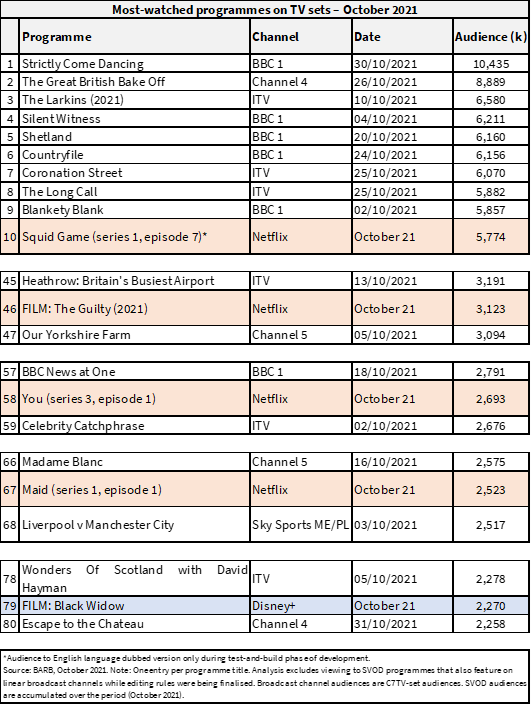On an episode of Richard Osman’s House of Games that aired at the start of this week, there was a question in the Distinctly Average round that made me sit up. The celebrity contestants are paired up and each must answer a numerical question that is usually based around making an estimation. They’re not expected to know the precise answer. Then an average of the two contestants on each team is produced and that forms their team answer (The round might have been inspired by the book, The Wisdom of Crowds).
You can see the question that was asked at the top of the page: According to October 2019 figures from RAJAR, approximately how many adults listen to the radio each week in the UK?
As regular readers of this blog will know, this is an answer I do know. It’s about 48.5m or 88% of the adult population (for that particular sweep of RAJAR).
But the interesting thing for this round is to listen to the logic that contestants use to come up with their numbers. The producers don’t really expect them to get it right, and indeed Osman himself will chip in with little comments if they make wildly inaccurate guesses. But I was interested to hear the thinking of a random assortment of celebrities willing to take part in a fun tea-time quiz. I should also note that those guesses have to be made on the spur of the moment, without calculators or the internet to hand. That’s the fun of the round of course.
One contestant said that they thought the number of radio listeners was quite low, and that although it used to be big, “Lots of people listen to podcasts now.” They guessed 1m. (Richard Osman responded with, “That’s the sound of the entire British radio industry going, ‘Oh no…’”)
Her team-mate guessed a not unreasonable 35m. The other team guessed 20m and 6m respectively (“I have a vague memory that the [?] breakfast show gets about 2m, so I’ve gone up from that.”). That left team averages of 18m and 13m against the real answer of 48.5m which was met with an audible gasp. Everyone vastly underestimated the true number of radio listeners.
I’m not really pointing fingers at the folk on this show – there have been far more egregious estimations than this – but really to highlight some of the perceptions there are about “new media” versus “old media.” Radio is something your parents did and everyone listens to podcasts today.
Indeed I suspect many, even in the podcast industry itself, believe that theirs is far bigger than old-fashioned radio.
Surely everyone listens to podcasts and uses Spotify?
Tomorrow we are due to get the results of the first UK-based Infinite Dial report on audio listening in the UK that should be comparable with similar figures in other countries that the report’s originator, Edison Research publishes. But in the meantime, RAJAR’s most recent MIDAS data suggests that around 18% of the UK population listens to podcasts (against 88% who listen to the radio) in a given week. That’s basically five times more people who listen to the radio than listen to podcasts.
I’ve no doubt that this number will change over time, and if you counted over a month and not a week, you’d get different answers. But in general humans are not good at estimating how new technologies disrupt older ones. Just because I personally listen to more podcasts than radio programmes doesn’t mean that you do the same.
In this light, it was interesting to see that the UK TV audience measurement body, BARB, has just announced a “once in a generation upgrade” to its reporting system to incorporate subscription video on demand (SVOD) service ratings into their overall ratings report. In other words, BARB is now measuring Netflix, Amazon Prime Video and Disney+ alongside the BBC, ITV and other British TV broadcasters.
And this allows us to begin to answer questions like, “Which was bigger in October? Coronation Street or Squid Game?”
It was Corrie.
We have to be a little bit careful. BARB’s data measures viewing on TV sets, although they also measure all consumption via WiFi in the home. That means that viewing of Netflix on your phone on the train won’t count towards this measure (Viewing of services like the BBC’s iPlayer and the ITV Hub would be measured on mobile because the broadcasters work with BARB to tag it accordingly).
But the TV set comparisons are interesting because they are comparing like with like.

Squid Game was Netflix’s biggest ever hit, and it just squeezed into the UK top ten last month.
Indeed, the chart shows a total of five SVOD shows getting into the top 100 for October 2021. Note that only the biggest single episode is counted. But BARB counts the different services consistently, and it isn’t based on metrics generated by some of the digital platforms themselves which can obfuscate things and make direct comparisons hard to achieve.
It’s worth noting that BARB uses a panel of around 5,300 homes which have agreed to let their viewing habits be recorded. They use an Establishment Survey to regularly maintain the panel’s make-up, and they supplement their panel data with census data from broadcasters’ own services (e.g. iPlayer data from the BBC). So BARB should be able maintain a pretty accurate view of how many UK subscribers their are to Netflix etc., based on their sampling rather than relying on, say, Netflix revealing their numbers.
Now different channels and broadcasters have different needs from ratings. For example:
- ITV needs ratings so they know how much to charge advertisers
- The BBC needs ratings to ensure that they’re providing a service for all Licence Fee payers
But of course, Netflix knows how many subscribers they have, and they have a detailed picture of what those subscribers are watching. Netflix doesn’t need a public picture of subscribers’ viewing habits. They don’t have advertisers to placate either.
That said, they do have to work with talent, representatives for whom like to know about how popular projects are. A runaway hit tends to mean bigger paychecks for agents’ clients. Big movie stars might even get a percentage of the box office (See the recent contretemps between Disney and Scarlett Johansson over Black Widow. When Disney+ made it available online as well as in cinemas, Johansson argued that box office takings would be reduced, and since she was in part being paid via a share of those takings, Disney was costing her money. In the end, Disney seemingly paid out).
That’s why we’re seeing Netflix and others, perhaps begrudgingly reveal more data such as via its new website https://top10.netflix.com/.
Except that even then, we’re getting data that’s not easy to compare with other data. The cumulative hours something was streamed don’t really account for viewers who bailed out of a show after a few minutes. And films with longer run-times, or series with more episodes are likely to do better than those with shorter run-times or fewer episodes. On the other hand, when I stream a show on Netflix, Netflix doesn’t really know who else is watching with me. BARB TV data accommodates that.
So what does this all boil down to saying? I guess two things, both of which some may find surprising in their streaming-first bubbles.
Lots of people listen to podcasts, but many more people listen to the radio.
Lots of people watch Netflix, but the biggest shows in the UK are actually nearly all on broadcast television.
Come back in five years, and this picture may have changed a lot more. But in the meantime, TV and radio remain massive.

